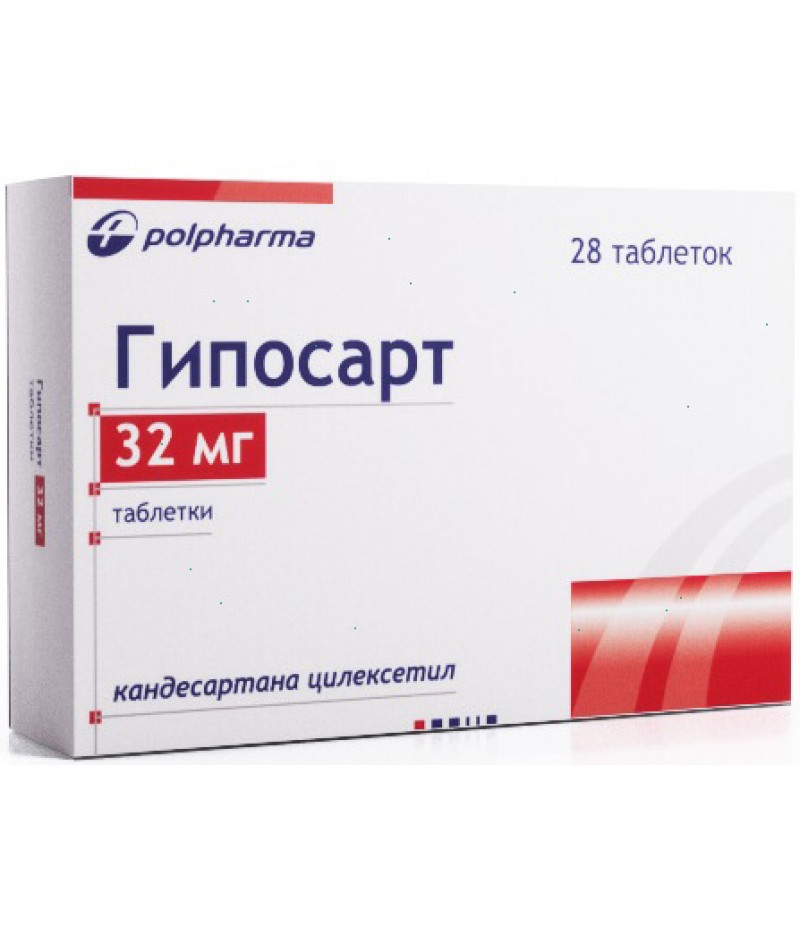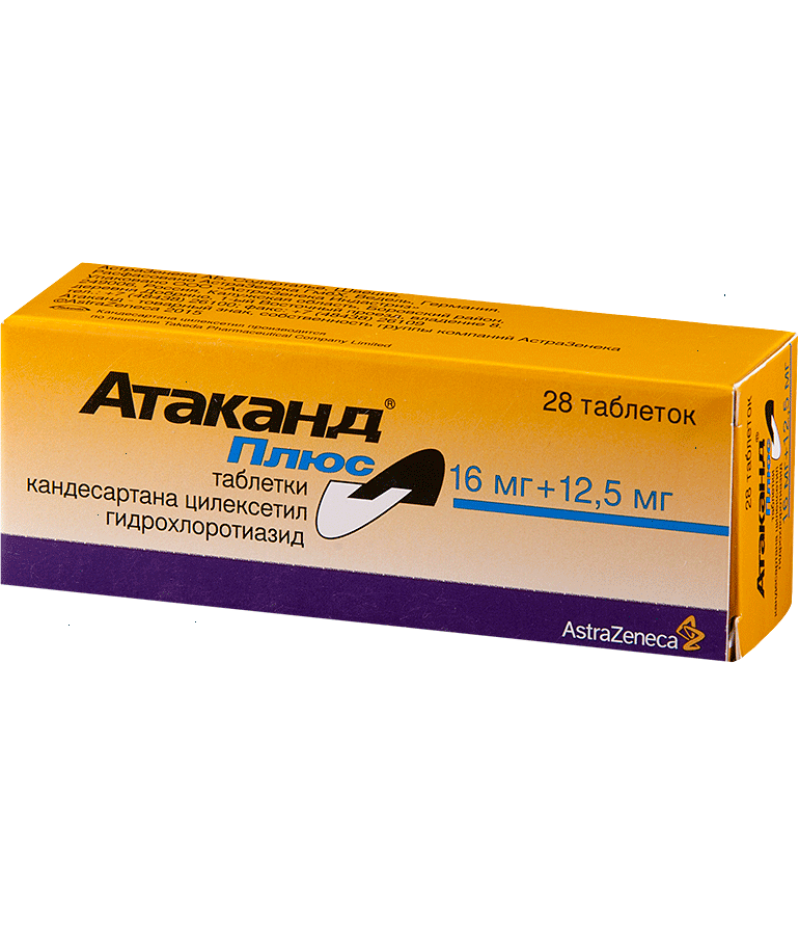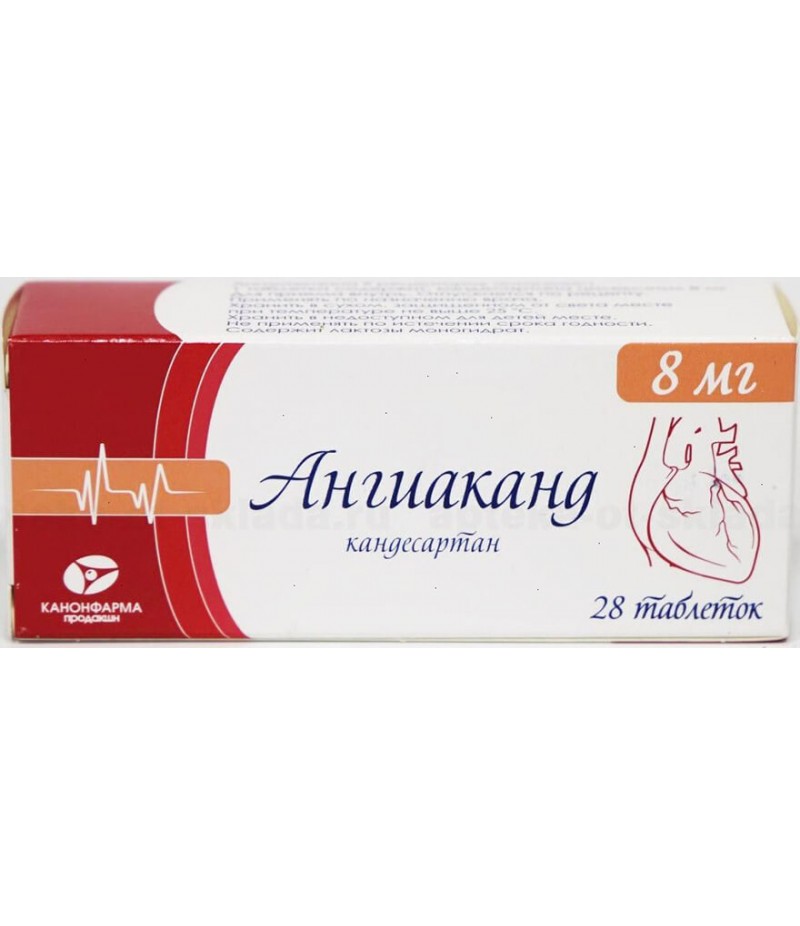Hyposart tabs 32mg #28
- $23.15
- 3 or more $22.90
- Availability:In Stock
Hyposart instructionYou can buy Hyposart on this pageComposition1 tab.candesartan cilexetil 16 mgExcipients: lactose monohydrate - 87 mg, corn starch - 20 mg, hyprolosis (viscosity, water, 25 ° С (5%)
Tags: tabs
Hyposart instruction
You can buy Hyposart on this page
Composition
1 tab.
candesartan cilexetil 16 mg
Excipients: lactose monohydrate - 87 mg, corn starch - 20 mg, hyprolosis (viscosity, water, 25 ° С (5%) 75-150 spz) - 2 mg, hyprolosis (viscosity, water, 25 ° С (5%) 1500-3000 spz) - 2 mg, macrogol 6000 - 2.6 mg, magnesium stearate - 0.4 mg.
Packaging - 14, 28 or 56 pcs.
Hyposart, indications for use
arterial hypertension;
chronic heart failure and violation of the systolic function of the left ventricle (LVEF ≤40%) as an additional therapy to ACE inhibitors or in case of intolerance to ACE inhibitors.
Contraindications
severe hepatic dysfunction and / or cholestasis;
simultaneous use with aliskiren and aliskiren-containing drugs in patients with diabetes or renal impairment (GFR
lactose intolerance, lactase deficiency, glucose-galactose malabsorption syndrome;
children and adolescents under 18 years of age (efficacy and safety have not been established);
Hypersensitivity to candesartan or other components of the drug.
With caution, you should prescribe the drug for severe renal impairment (CC
Dosage and administration
The drug is taken orally, 1 time / day, regardless of the meal.
Arterial hypertension
The recommended initial and maintenance dose of Hyposart is 8 mg 1 time / day. If necessary, the dose can be increased to 16 mg 1 time / day. Maximum antihypertensive effect is achieved within 4 weeks of therapy. The maximum daily dose is 32 mg 1 time / day.
If, against the background of the maximum daily dose, adequate blood pressure control is not achieved, it is recommended to add thiazide diuretic (for example, hydrochlorothiazide) to therapy. This can enhance the antihypertensive effect of Hyposart.
In patients at risk of developing arterial hypotension (including patients with reduced BCC), therapy is recommended to start with a dose of 4 mg.
In patients with impaired mild to moderate renal function (CC 30-80 ml / min / 1.73 m2), including patients on hemodialysis, the initial dose of the drug is 4 mg. The dose should be titrated depending on the therapeutic effect. Clinical experience with the use of the drug in patients with impaired severe kidney function or end-stage renal failure (CC less than 15 ml / min) is limited.
The initial daily dose of the drug in patients with mild and moderate liver disease is 4 mg. May increase the dose if necessary. Clinical experience with the drug in patients with severe liver dysfunction and / or cholestasis is absent.
Chronic heart failure
The recommended initial dose of Hyposart is 4 mg 1 time / day. An increase to a maximum daily dose of 32 mg 1 time / day or to the maximum tolerated dose is carried out by doubling the dose at intervals of at least 2 weeks.
Elderly patients and patients with impaired renal or hepatic function do not require correction of the initial dose of the drug.
The safety and efficacy of Hyposart use in children and adolescents under the age of 18 years have not been established.
Concomitant therapy
Hyposart preparation can be used simultaneously with other drugs for treating CHF, including ACE inhibitors, beta-blockers, diuretics, cardiac glycosides, or combinations of these drugs.
Use during pregnancy and lactation
Hyposart preparation is contraindicated for use during pregnancy, because it has a direct effect on the RAAS and can cause developmental disorders of the fetus (especially in the second and third trimesters of pregnancy) or have a negative effect on the newborn, even death, if the drug was used during pregnancy.
It is known that therapy with angiotensin II receptor antagonists (ARA II) can cause impaired fetal development (renal dysfunction, oligohydramnios, delayed ossification of the skull bones) and the development of complications in the newborn (renal failure, arterial hypotension, hyperkalemia). When establishing the fact of pregnancy, the drug Hyposart must be canceled as soon as possible.
When planning a pregnancy, it is necessary to transfer the patient to an adequate alternative therapy.
It is not known whether candesartan is excreted in breast milk, but it is known that it penetrates the milk of lactating rats.
During treatment with Hyposart, breastfeeding should be stopped. Newborns whose mothers took Hyposart during pregnancy should be under close medical supervision due to the likelihood of arterial hypotension.
Side effects of Hyposart
Classification of the incidence of side effects: very often (≥1 / 10); often (≥1 / 100,
The side effects of candesartan are mild and transient. The frequency of side effects does not depend on the dose of the drug and the age of the patient.
From the nervous system: often - dizziness, headache, weakness.
Since the cardiovascular system: often - an excessive decrease in blood pressure.
On the part of the respiratory system: often - respiratory infections, pharyngitis, rhinitis, cough.
On the part of the digestive system: very rarely - nausea, increased activity of hepatic transaminases, impaired liver function or hepatitis.
On the part of the urinary system: often - impaired renal function, including renal failure in susceptible patients.
On the part of the musculoskeletal system: very rarely - back pain, arthralgia, myalgia.
On the part of the hematopoietic system: very rarely - leukopenia, neutropenia, thrombocytopenia and agranulocytosis.
Laboratory indicators: very rarely - hyperkalemia, hyponatremia, increased concentration of creatinine in the blood, hyperuricemia, a slight decrease in hemoglobin.
Allergic reactions: very rarely - angioedema, skin rash, itching, urticaria.
Others: exacerbation of the flow of gout, "tides" of blood to the skin of the face.
special instructions
Application for violations of the liver
In the treatment of arterial hypertension, the initial daily dose of a drug of patients with mild and moderate liver diseases is 4 mg. May increase the dose if necessary. Clinical experience with the drug in patients with severe liver dysfunction and / or cholestasis is absent.
In the treatment of chronic heart failure patients with impaired liver function does not require correction of the initial dose of the drug.
Use of the drug is contraindicated in case of severe liver function and / or cholestasis.
Application for violations of renal function
In the treatment of arterial hypertension in patients with impaired mild to moderate renal function (CC 30-80 ml / min / 1.73 m2), including patients on hemodialysis, the initial dose of the drug is 4 mg. The dose should be titrated depending on the therapeutic effect. Clinical experience with the use of the drug in patients with impaired severe kidney function or end-stage renal failure (CC less than 15 ml / min) is limited.
In the treatment of chronic heart failure patients with impaired renal function does not require correction of the initial dose of the drug.
With caution, you should prescribe the drug for severe renal impairment (CC
Use in children
The drug is contraindicated in children and adolescents under 18 years of age (efficacy and safety have not been established).
Use in elderly patients
Elderly patients do not require correction of the initial dose of the drug.
Ethnic features
The antihypertensive effect of candesartan in patients of the Negroid race is less pronounced compared to patients of other races, and therefore, an increase in the dose of Hyposart is often required, as well as a combination with other antihypertensive drugs.
Renal dysfunction
Experience in the use of the drug in patients with severe renal insufficiency or in end-stage renal disease (QC
Patients with CHF, especially those over the age of 75, and patients with impaired renal function need to periodically monitor their renal function. During the selection of the dose of Hyposart, it is recommended to monitor the concentration of creatinine and potassium in the blood serum.
Combination therapy with an ACE inhibitor for CHF
When using the drug Hyposart in combination with an ACE inhibitor may increase the risk of side effects: impaired renal function and hyperkalemia. In these cases, careful monitoring and control of relevant laboratory parameters is necessary.
Hemodialysis
During hemodialysis, blood pressure may be especially sensitive to blockade of AT1 receptors as a result of a decrease in the BCC and activation of the RAAS. Therefore, patients on hemodialysis, need to control blood pressure and individual selection of the dose of the drug Hyposart.
Renal artery stenosis
Preparations that affect RAAS, for example, ACE inhibitors, can cause hyperuricemia and hypercreatininemia in patients with bilateral renal artery stenosis or arterial stenosis of a single kidney. A similar effect may develop with the use of APA II.
Kidney transplantation
The experience of using the drug in patients who have recently undergone kidney transplantation is absent.
Hypotension
Patients with CHF who receive Hyposart may develop hypotension. Arterial hypotension may also develop in patients with reduced BCC, for example, receiving diuretics in high doses. At the beginning of therapy, care must be taken and if necessary, compensate for the BCC.
General Anesthesia / Surgery
When performing surgical interventions under general anesthesia in patients taking ARA II, hypotension may develop due to blockade of the RAAS. Very rarely, arterial hypotension can be severe and may require intravenous fluids and / or vasopressors.
Stenosis of the aortic and / or mitral valves, GOKMP
Hyposart preparation should be used with caution in patients with hemodynamically significant stenosis of the aortic and / or mitral valves or with GOKMP.
Primary hyperaldosteronism
Patients with primary hyperaldosteronism are resistant to antihypertensive drugs that affect the RAAS, so these patients are not recommended to use Hyposart.
Hyperkalemia
Simultaneous use of the drug Hyposart and potassium-saving diuretics, potassium preparations, salt substitutes containing potassium, or other drugs that can increase the concentration of potassium in serum (eg, heparin), can lead to the development of hyperkalemia in patients with arterial hypertension. Hyperkalemia can also develop in patients with CHF who take Hyposart. During therapy with Hyposarth, patients with CHF should be periodically monitored for serum potassium concentrations, especially with simultaneous use of ACE inhibitors and potassium-sparing diuretics (spironolactone, eplerenone, triamterene, amiloride).
Are common
Patients whose vascular tone and kidney function are primarily dependent on the activity of the RAAS (for example, patients with severe decompensated CHF or concomitant kidney disease, including unilateral stenosis of the renal artery), therapy with other drugs affecting the RAAS, may be accompanied by the development of arterial hypotension, azotemia, oliguria and, less commonly, acute renal failure. This cannot be ruled out for angiotensin II receptor antagonists. An excessive decrease in blood pressure in patients with coronary artery disease or cerebrovascular disease of ischemic genesis can lead to the development of myocardial infarction or stroke.
Double blockade of RAAS when using preparations containing aliskiren
Double blockade of the RAAS is not recommended by the simultaneous use of candesartan and aliskiren, due to the increased risk of arterial hypotension, hyperkalemia and renal dysfunction.
Influence on ability to drive motor transport and control mechanisms
The effect of Hyposart on the ability to drive and work with complex mechanisms has not been studied, but the pharmacodynamic properties of the drug indicate that there is no such effect. Care must be taken when driving vehicles and practicing potentially hazardous activities that require increased concentration and psychomotor speed due to the risk of dizziness.
Interaction
The use of candesartan simultaneously with drugs containing aliskiren is contraindicated in patients with diabetes mellitus or moderate and severe renal insufficiency (GFR2).
The simultaneous use of candesartan with hydrochlorothiazide, warfarin, digoxin, oral contraceptives (ethinyl estradiol / levonorgestrel), glibenclamide, nifedipine and enalapril was studied; no clinically significant pharmacokinetic interaction observed.
Candesartan is slightly metabolized in the liver (using CYP2C9 isoenzyme). No effect on CYP2C9 and CYP3A4 isoenzymes; the effect on other cytochrome P450 isoenzymes is currently unknown.
Antihypertensive drugs potentiate the antihypertensive effect of candesartan. Experience with other drugs acting on the RAAS shows that the simultaneous use of the drug and potassium-sparing diuretics (spironolactone, eplerenone, triamterene, amiloride), potassium preparations, potassium-containing salt substitutes, or other drugs that can increase the concentration of potassium in serum ( for example, heparin), can lead to the development of hyperkalemia.
With the simultaneous use of lithium preparations and ACE inhibitors, there have been cases of a transient increase in the concentration of lithium in the blood serum and the development of toxic effects. A similar effect is possible with the simultaneous use of lithium preparations and angiotensin II receptor antagonists, which requires periodic monitoring of the serum lithium concentration in the combined use of these drugs.
With simultaneous use of ARA II and NSAIDs, including selective COX-2 inhibitors and non-selective NSAIDs (for example, acetylsalicylic acid at a dose of more than 3 g / day), the antihypertensive effect of candesartan may be reduced.
Double blockade of RAAS
As in the case of ACE inhibitors, the simultaneous use of ARA II and NSAIDs increases the risk of reduced renal function, up to the development of renal failure, which leads to hyperkalemia in patients with impaired renal function. This combination should be used with caution, especially in elderly patients. All patients should receive an adequate amount of fluid; it is necessary to monitor the kidney function at the beginning of therapy and in the future.
Overdose
Symptoms: excessive decrease in blood pressure, dizziness, tachycardia. Individual cases of drug overdose are described (up to 672 mg of candesartan cilexetil), which ended in the recovery of patients without serious consequences.
Treatment: with an excessive decrease in blood pressure, the patient should be placed in a horizontal position with a low head; then - to carry out activities aimed at increasing the BCC (introduction of a 0.9% solution of sodium chloride in / in). If necessary, sympathomimetic drugs may be prescribed. Symptomatic therapy is recommended under the control of vital body functions. Hemodialysis is ineffective.
Storage conditions
Shelf life - 2 years.
The drug should be stored out of the reach of children at a temperature not higher than 25 ° C.
Terms of sell
You can buy Hyposart without a prescription.
Reviews
Tatiana
Atakand 16 was appointed could, but the price of non-state is very expensive. I looked at what analogues there were, found Hyposart. Now I accept him, very pleased. Good price, very good quality. Also holds AD.




